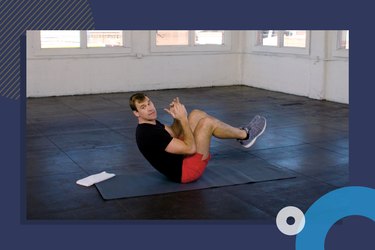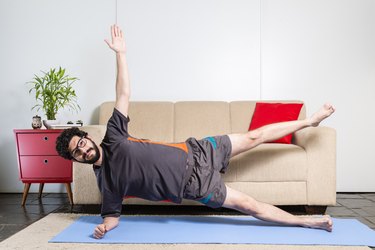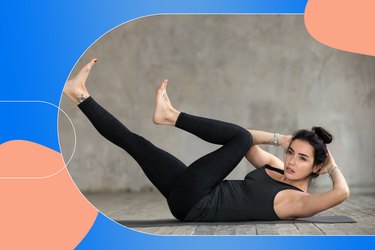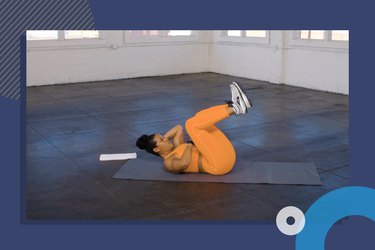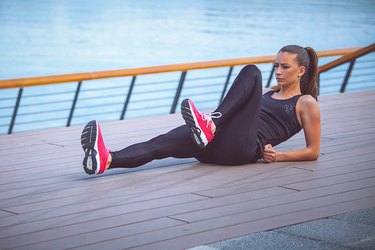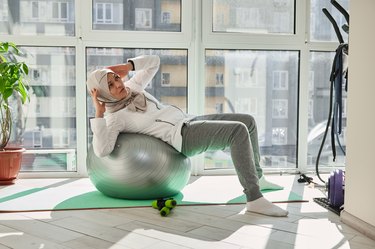
Some things — like baking croissants or choreographing a dance routine — require perfect timing. Others, though, are a little more flexible. Take your ab workouts for example. Whether you spend 5, 10 or 30 minutes on your abs each time you work out depends on a number of factors.
So, how do you figure out how much time you should spend on ab workouts? We asked a couple of personal trainers for the lowdown.
Video of the Day
Video of the Day
How Long Should Ab Workouts Last?
"You don't actually need to perform an ab workout for too long, provided you're doing other full-body, functional movements," says Sydney Miller, personal trainer and founder of the HOUSEWORK fitness app.
Any movements that involve picking things up, balancing, squatting or lunging — especially with weights — call for abdominal strength to keep your body stabilized during the movement.
As far as dedicated ab workouts, how much time you spend will depend on your experience level, goal, workout intensity and how often you can realistically fit an ab workout into your schedule.
If you're an ab newbie, build consistency with a short, doable routine. "Try committing to 5 minutes a day, and you'll definitely see results," Miller says. That might look like tacking a few ab exercises onto the end of your usual strength or cardio workout or doing a quick session as part of your morning routine.
"Start small with an ab workout that you have fun doing and make sure you have some good music on," Miller says.
If you're interested in using ab workouts to boost performance in running, weightlifting or another sport, your best move is to perform full-body exercises that engage your core, then blast your abs at the end with a dedicated routine. This helps ensure you don't exhaust your ab muscles before the bulk of a full-body workout, but you can start with some gentler ab activation exercises to warm up.
"In total, this entire workout [might be] about 30 minutes, including 5 to 8 minutes of only abs," Miller says.
If you're pressed for time, high-intensity interval training (HIIT) is a great way to squeeze in a quick-but-effective ab workout. Miller recommends going for at least 10 to 15 minutes to really get your sweat on and also feel your abs working.
And if you can only afford to focus on your abs once or twice a week? Don't sweat it. Ten minutes is a solid amount of time to work your abs, Miller says.
Try One of These Quick Ab Workouts
How to Progress Your Ab Workouts
A great way to build up to longer ab workouts is to engage your abdominal muscles as much as possible, says Jessica Mazzucco, an NYC-based fitness trainer and founder of The Glute Recruit. Aim to involve your abs anytime you perform strength or cardio workouts. When you squat, run or even do biceps curls, tighten your abs by bringing your bellybutton toward your spine.
You can also try activities like yoga and Pilates, which build abdominal strength, flexibility and proper posture, Mazzucco says. Not to mention, it's a great way to mix up your workout routine.
As you get stronger, add more ab exercises to your workout — and think beyond basic crunches and planks.
"To make sure you hit more than just the superficial top layer of your abdominal muscles, it's important to use a variety of movements that also target the obliques and deep core muscles," Miller says. She suggests moves like slider lunges with weights, rollouts, V-ups, bicycle crunches, bird dogs and side bends.
Mazzucco suggests starting with a baseline of 10 to 15 reps of each exercise and repeating for a total of 2 to 3 rounds. Add 5 to 10 reps to your sets once things get easier.
Try This 3-Move Ab Workout
1. Stability Ball Knee Tuck
- Start on all fours with your knees under your hips and your hands under your shoulders. Place a stability ball behind your feet.
- Slowly lift one leg and set the top of your foot and shin on the stability. Once you're set, lift the other leg onto the ball. Extend your legs so your body forms a straight line from your head to your heels.
- Engage your abs to draw the ball toward your chest as you bend the knees and tuck your lower body up to your torso.
- Hold for a few seconds, then extend the knees as you roll the stability ball away from your torso. You should return to a full plank position.
- Do 2 to 3 sets of 8 to 12 reps.
Tip
For safety, have someone spot you while doing this exercise.
“Keep in mind: The closer your feet are together, the harder it is to maintain balance,” Mazzucco says. You can also make the move harder, by lifting your hips toward the ceiling as you extend your legs back.
2. Body-Weight Single-Leg Deadlift
- Stand tall with your hands at your sides and thumbs facing outward.
- Hinge forward at the hips as you lift one leg straight behind you while keeping the other leg planted and the knee slightly bent. As your leg lifts, extend your arms to the sides to form a T shape. Your body should create a straight line from the ankle to the ear while keeping the chest tall and thumbs pointing up.
- Hold for a few seconds, then slowly bring your extended leg to the starting position.
- Repeat, aiming for 2 to 3 sets of 13 to 22 reps per leg.
Tip
If you have trouble balancing, hold onto a countertop or another surface.
3. Crab Toe Touch
- Sit on the floor with your knees bent, feet in front of you and your palms planted on the floor directly behind you, fingers pointed away from your body.
- Press into the floor with your hands and lift your hips an inch.
- With your hips lifted, kick your right leg up so it's extended in front of your body. Try to touch your right toes with your left hand
- Place your right foot on the floor, and kick your left leg up and touch your left toes with your right hand.
- Continue alternating legs, aiming for 2 to 3 sets of 12 to 16 reps.
